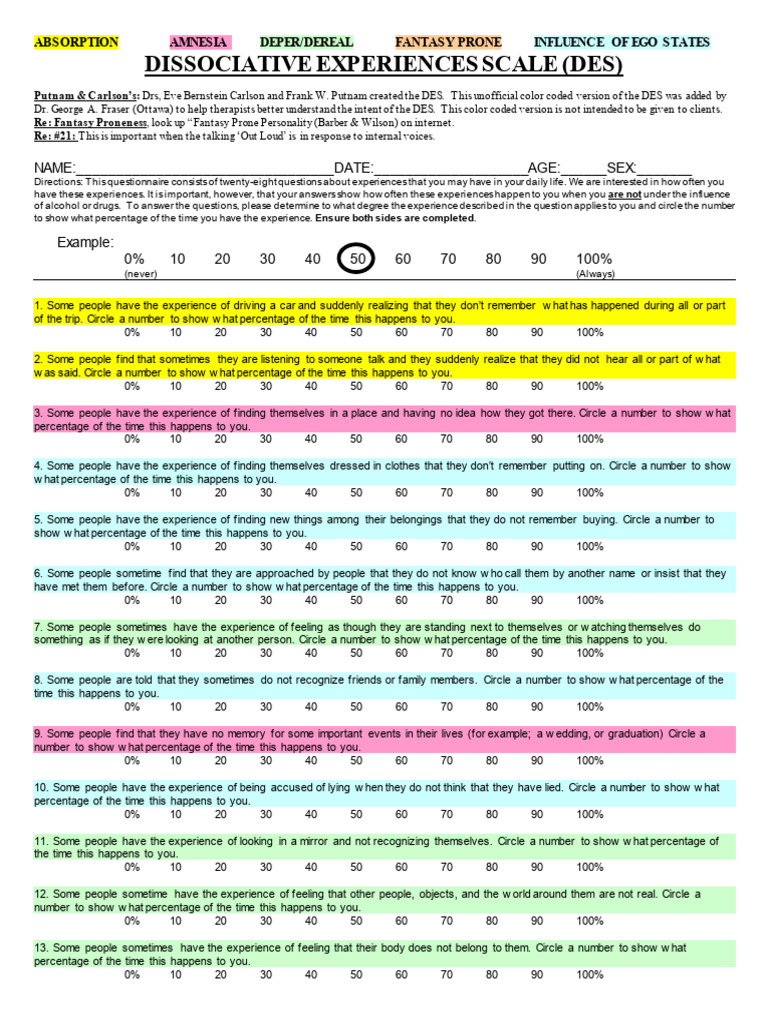The human psyche often resembles a vast ocean, its depths as mysterious as they are profound. Just as the ocean’s surface can appear tranquil while turbulence bubbles beneath, our mental landscape can hide complexities that profoundly influence our thoughts, emotions, and behaviors. One especially enigmatic aspect of this landscape is dissociation, a psychological phenomenon that can range from mild daydreams to severe disruptions in identity and self-awareness. To explore this spectrum, mental health professionals frequently employ psychological tools, one of which is the Dissociative Experiences Scale II (DES-II).
At its core, the DES-II is a psychometric instrument designed to gauge the frequency and intensity of dissociative experiences. Developed as a refined successor to its predecessor, the DES-I, it illuminates the nuanced shades within the dissociative spectrum. It serves as a mirror that reflects the often obscured intricacies of one’s internal world—a guide through the labyrinth of dissociation. Understanding its purpose, methodology, and the implications of its results is pivotal for both practitioners and individuals navigating the turbulence of dissociative symptoms.
Understanding Dissociation
Dissociation can be likened to an inconspicuous break in the fabric of consciousness. This psychological mechanism serves as a defense, allowing individuals to detach from overwhelming emotions or memories. While mild forms of dissociation are commonplace—such as zoning out during a monotonous meeting—more severe dissociative states can manifest as feeling disconnected from one’s body or experiencing gaps in memory. It’s as if the mind hits the pause button, detaching from the immediate reality to escape from mental strain or trauma.
The DES-II quantitatively measures this dissociation, probing the frequency of specific experiences that participants may encounter regularly. These experiences are categorized into various dimensions, such as depersonalization—feeling detached from oneself—and derealization—perceiving the world as unreal. By highlighting these dimensions, the DES-II provides a rich tapestry of understanding, uncovering threads of experience often woven tightly in a person’s identity.
The Mechanics of the DES-II
The DES-II consists of 28 items aimed at eliciting responses regarding the frequency of dissociative experiences within specific time frames. Participants rate each item on a scale from 0 to 100, allowing for a nuanced understanding of how often they encounter these dissociative phenomena. This method enables individuals to paint an intricate picture of their dissociative experiences, as if sifting through the sands of their consciousness and revealing hidden gems.
Questions may prompt reflections on seemingly benign occurrences: “How often do you find yourself losing your train of thought?” or “Do you ever feel as though your thoughts are not your own?” Each inquiry serves as a stepping stone across the vast and variable landscape of dissociation. The cumulative score reflects not merely the presence of dissociative experiences but also aids in distinguishing between varying levels of severity, facilitating targeted interventions.
The Significance of Scoring
Interpreting the scores yielded by the DES-II is akin to deciphering a secret code that unlocks the complexities of an individual’s subconscious. Scores generally categorize individuals into low, moderate, or high dissociation groups, offering clinicians insights into the severity of symptoms and potential underlying issues. For example, a higher score may indicate the presence of severe psychological distress, often linked to trauma or a dissociative disorder, necessitating a more intricate therapeutic approach.
Furthermore, tracking changes in DES-II scores over time can provide invaluable data for both therapist and client. As individuals embark on their journey through therapy, fluctuations in scores may mirror their progress, marking milestones of recovery and transformation. The vague contours of difficult experiences gradually sharpen into clarity, allowing for healing and reconnection with oneself.
Utilizing the DES-II in Clinical Practice
In practice, clinicians employ the DES-II not only as a diagnostic tool but also as an integral part of treatment planning. Understanding the extent of dissociation can assist in formulating strategies tailored to individual needs. For instance, if mild dissociation predominates, cognitive behavioral interventions might be employed to address cognitive distortions and enhance mindfulness. In contrast, if the score reflects significant dissociative experiences, trauma-informed care may become paramount, focusing on safe ways to process and integrate the trauma.
Moreover, the DES-II can foster open dialogues between clinician and client. It acts as a conduit for exploration, allowing clients to articulate their internal conflicts and experiences without judgment. Such candid exchanges create a collaborative atmosphere, essential for effective therapeutic engagement.
Conclusion: The Journey of Self-Discovery
Ultimately, the DES-II stands as a vital resource for comprehending the multifaceted nature of dissociation. It invites individuals to embark on a journey of self-discovery, casting light on the shadows of their minds. In navigating the ocean of consciousness, it offers the tools necessary to map their unique terrain, fostering resilience and healing through understanding. Armed with these insights, individuals can forge a path towards a more integrated sense of self, bridging the divides between dissociation and connection, past and present.
Embracing the complexities inherent in our psychological constructs is not merely an academic pursuit; it embodies the essence of the human experience—constantly evolving, ever-enigmatic, yet profoundly relatable. The DES-II is but one vessel navigating this vast ocean, guiding us toward understanding, acceptance, and ultimately, a sense of wholeness.
